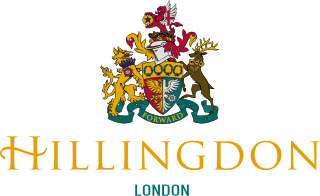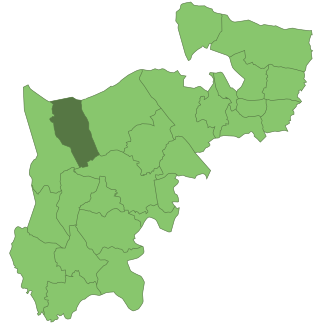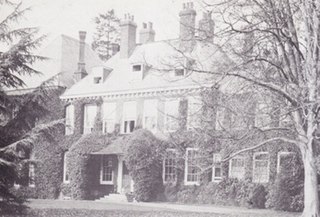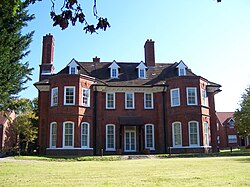
Ickenham is an area in Greater London, forming the northern part of Uxbridge and within the London Borough of Hillingdon.

Northwood is an area in the London Borough of Hillingdon, located 14.5 miles (23.3 km) north-west of Charing Cross. Northwood was part of the ancient parish of Ruislip, Middlesex. The area was situated on the historic Middlesex boundary with Hertfordshire, and since being incorporated into Greater London in 1965, has been on the Greater London boundary with that county.

Ruislip is an area in the London Borough of Hillingdon in West London. Prior to 1965 it was in Middlesex. Ruislip lies 13.8 miles (22.2 km) west-north-west of Charing Cross, London.

The London Borough of Hillingdon is the largest and westernmost borough in West London, England. It was formed in 1965 from the districts of Hayes and Harlington, Ruislip-Northwood, Uxbridge, and Yiewsley and West Drayton in the ceremonial county of Middlesex. Today, Hillingdon is home to Heathrow Airport and Brunel University, and is the second largest of the 32 London boroughs by area.

South Ruislip is an area of west London in the London Borough of Hillingdon, south-east of Ruislip, south of Eastcote, north-west of Northolt, and west of South Harrow. A 2017 estimation put the population of South Ruislip ward as 13,150 residents.

Eastcote is a suburban area in the London Borough of Hillingdon, in west London.

Ruislip-Northwood was a borough constituency represented in the House of Commons of the UK Parliament from 1950 to 2010 that elected one member (MP) by the first past the post system of election. It was centred on the districts of Ruislip and Northwood in the London Borough of Hillingdon.

Ruislip-Northwood was an urban district in west Middlesex, England, from 1904 to 1965. From its inception Ruislip-Northwood fell within the Metropolitan Police District and from 1933 it was part of the London Passenger Transport Area.

Ruislip, Northwood and Pinner is a constituency in Greater London represented in the House of Commons of the UK Parliament since 2019 by David Simmonds, a Conservative.

Ruislip Manor is an area of Ruislip in the London Borough of Hillingdon in West London. It is located approximately 13 miles (20.9 km) west north west of Charing Cross.

Ruislip Lido is a reservoir and artificial beach in Ruislip, within the London Borough of Hillingdon, England, situated between Ruislip Common, Ruislip Woods, and Poor's Field.

Mount Vernon Hospital is a hospital located in Northwood in the London Borough of Hillingdon. It is one of two hospitals run by The Hillingdon Hospitals NHS Foundation Trust, the other being Hillingdon Hospital.

Project MoDEL is a project run for the Ministry of Defence (MoD) by the ministry's Defence Infrastructure Organisation and VSM Estates, a joint venture established between Vinci PLC and St. Modwen Properties to bid for the contract. The project involves the consolidation and sale of surplus Ministry of Defence properties around Greater London into around £180m of new developments at RAF Northolt. A total of 80% of the existing buildings at RAF Northolt were demolished and replaced by the newly built facilities.

Ruislip Woods is a Site of Special Scientific Interest and national nature reserve covering 726 acres (294 ha) in Ruislip in the London Borough of Hillingdon. The woods became London's first national nature reserve in May 1997. Ruislip Local Nature Reserve at TQ 090 899 is part of the national nature reserve.

RAF Eastcote, also known over time as RAF Lime Grove, HMS Pembroke V and Outstation Eastcote, was a UK Ministry of Defence site in Eastcote, Middlesex.

Manor Farm is a 22-acre (8.9 ha) historic site in Ruislip, Greater London. It incorporates a medieval farm complex, with a main old barn dating from the 13th century and a farm house from the 16th. Nearby are the remains of a motte-and-bailey castle believed to date from shortly after the Norman conquest of England. Original groundwork on the site has been dated to the 9th century.

St Martin's Church is a church in the west London town of Ruislip, within the London Borough of Hillingdon. It has been designated since January 1950 by English Heritage as a Grade I listed building. The present chancel and nave date back to the 13th century. The church stands at the northern end of Ruislip High Street, near the Manor Farm site.

Eastcote House Gardens is an area of public parkland in Eastcote, within the London Borough of Hillingdon. The site covers 3.63 hectares and incorporates the walled garden, dovecote and coach house of Eastcote House. The house was demolished in 1964 by the then Ruislip-Northwood Urban District Council (RNUDC), one of the predecessors of the London Borough of Hillingdon which was formed the following year. At the public's request, the garden and outbuildings were retained and are now maintained by a group of volunteers, the Friends of Eastcote House Gardens, in partnership with the local authority.

Haydon Hall was one of the three main houses of Eastcote, within what is now the London Borough of Hillingdon. The house was built in 1630 as a home for Lady Alice, Dowager Countess of Derby who had been living in Harefield. The house remained in the ownership of Lady Alice's descendants for several years, on the side of her eldest daughter. For a time the house was renamed "Eastcote Park" though was returned to the original name.




















